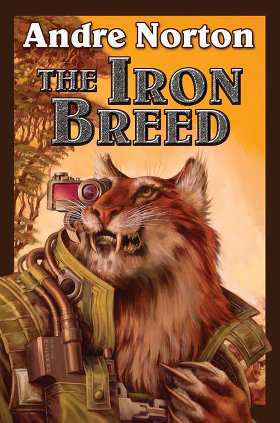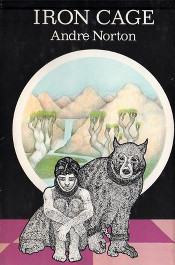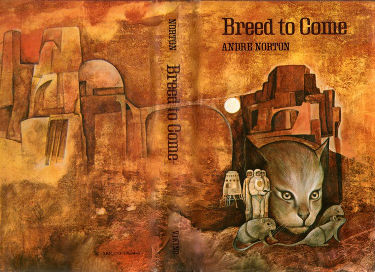Review: 'The Iron Breed', by Andre Norton
 Andre Norton (Alice Mary Norton, 1912-2005), “the Grand Dame of science-fiction”, was one of the first authors of Young Adult s-f, and of anthro s-f. At a time when most s-f featured teenage or adult human heroes fighting alien adversaries, her novels often starred humans working with sympathetic anthro aliens against human villains, anthro protagonists, or humans transformed into anthro aliens.
Andre Norton (Alice Mary Norton, 1912-2005), “the Grand Dame of science-fiction”, was one of the first authors of Young Adult s-f, and of anthro s-f. At a time when most s-f featured teenage or adult human heroes fighting alien adversaries, her novels often starred humans working with sympathetic anthro aliens against human villains, anthro protagonists, or humans transformed into anthro aliens.
Today, Baen Books is reprinting many of her out-of-print s-f titles, two novels in each book. The Iron Breed reprints two of her anthro classics together for the first time: Iron Cage (Viking Press, September 1974; original cover by Bruce Waldman) and Breed to Come (Viking Press, June 1972; original cover by László Gál). If you have not read them before, read them now.
Baen Books, January 2013, trade paperback $12 (448 pages), Kindle $8.99 (preview).
Iron Cage
Well, Iron Cage (pages 1–220) is not exactly an anthro classic. The protagonist is Jony, a human young adult with a mutant mental talent somewhere between super-empathy and mind control. Jony is introduced as a seven-year-old. He and his mother Rutee have been captured on their colony planet by wandering aliens.
In Chapters 1 and 2, Jony escapes his cage and joins Rutee when she is discarded, pregnant, by the aliens on an unknown planet. Jony persuades its kindly bearlike natives to take them both in. Chapter 3 jumps ahead about ten years. Rutee has died and Jony has grown to adolescence as an accepted member of the People’s tribe. He tries to look after his younger half-siblings, Rutee’s twins:
In the brilliant sunlight the patchy coloring of the People’s fur, which gave them such good concealment in the brush, looked ragged. There was no pattern to the splotches of light and dark which dappled their stocky bodies. The fur of all patches was a green-yellow but in such a diversity of shades as to make their outlines almost indiscernible even here in the open. Only on their round heads was the color laid in an even design of light on the muzzle, dark about their large eyes.
Jony and the twins were not so well provided with body covering, to his resentment and disgust. He did wear a kilt of drab, coarse stuff which was dabbled with berry and vine juice to resemble the People’s shading. But, compared to the soft fur of his companions, he considered it highly inadequate, which it was.
Though he lay at ease, his mind was alert on sentry duty. For more seasons than he could now count, for he had never tried to keep track, they had shared the life of the People. Formidable as they were (even a second season cub could best Jony in a friendly strength-match) they had their enemies, also. And Jony had early discovered that that inner sense of his was, in its way, a more accurate warning than any the People possessed. (pgs. 33-34)
 Jony has accepted the culture of the People’s clan, but his two half-siblings, Maba and Geogee, ignore their bearlike hunter-gatherer existence and are always causing trouble:
Jony has accepted the culture of the People’s clan, but his two half-siblings, Maba and Geogee, ignore their bearlike hunter-gatherer existence and are always causing trouble:
‘Yes,’ Geogee nodded. ‘Huuf goes, so we can…’
‘Huuf,’ Jony tried to put full emphasis on what he said now, ‘watches all the time. He does not run off and hide, or pretend he is lost in order to have the whole clan out hunting for him.’
Maba laughed. ‘That was fun,’ she broke out. ‘Even if Yaa did slap us when we got back. We want to go and see things, Jony, just not always stay around where the People are. They really don’t LIKE anything different to do.’
She was right, of course. But both the twins must learn caution, and they seemed unable to understand, or want to understand, that danger walked with the unknown. For Jony the situation was different. He was much older, bigger, and he had his warning sense to call upon. If the twins only had that, he would not have worried so about their taking off into the unknown. But they had not the least trace of his talent. (p. 39)
Maba’s and Geogee’s wanderings off get them trapped in ominous underground chambers with dusty pictures of spacefaring humans and old but still deadly futuristic weapons in them. When Jony rescues them and brings them back to the People, the bearlike natives become hostile and distraught, imprisoning him and taking him far from their ancestral homeland.
Though the People’s rather clumsy walk might seem less effective than his own loose stride, Jony was forced to quicken that to keep up with his guards. This pushing pace was quite unlike that generally kept when the clan was on the move. For then they were apt to seek edible roots, berries, scraper stones, over a wide area, each some distance from another as they traveled. […] They had gone some little distance before Jony noted ends of stones protruding here and there from the soil of the ridge. These had been squared, though exposure to the weather had pitted their surfaces, rounded the edges. In spite of Trush’s reaction to the stone path, the strangeness of the clan since Jony had confessed his visit to the place which had been made by the aliens of the pictures, Voak appeared to be heading on into a section where similar remains appeared. (pgs. 81-82)
Jony is abandoned into a lone exile. When a human spaceship comes to trap and exploit the People like dumb animals, Jony must figure out the true relationship between the humans, the Big One aliens that had captured him and Rutee on another world, and the People. He must decide whether to join his own kind, or fight for his adoptive community despite their having turned against him.
 Iron Cage is a good read, but the bearlike People are only intriguing anthropomorphic background characters. Iron Cage is Jony’s adventure, and he is human.
Iron Cage is a good read, but the bearlike People are only intriguing anthropomorphic background characters. Iron Cage is Jony’s adventure, and he is human.
Breed to Come
Breed to Come (pages 221-442), on the other paw, is a true anthropomorphic classic. It is arguably the earliest s-f novel to feature an evolved animal-man protagonist, as opposed to a fantasy novel with intelligent animal characters. (Norton used a very similar plot in Star Man’s Son, 2250 A.D. (Harcourt, Brace, August 1952), reprinted as Daybreak – 2250 A.D., but that featured a mutant human protagonist in a world of intelligent animals.) In the far future, humanity has become insanely reckless and, due to a deadly experimental “epidemic virus”, the humans have abandoned Earth. That same virus has caused the housecats, dogs, and rats left behind to evolve extremely rapidly into intelligent People (cats), Barkers, Tusked Ones (boars), and Rattons, each achieving a primitive civilization while the three fight over the relics of their “Demon” forerunners.
Furtig is a young cat-warrior:
To those who had known his ancestors, he would be a grotesque sight; for a body once well fitted to the needs of its owner had altered in ways strange to nature. Rounded forepaws had split into stubby fingers, awkward enough but able to accomplish much more in the way of handling. His body was still largely furred, but there were places where the fur had thinned to a light down. There was more dome to his skull, just as the brain beneath was different, dealing with thoughts and conceptions earlier unknown. In fact it was that brain which had altered most of all. Feline, Furtig’s ancestors had been. But Furtig was something which those who had known those felines could not have accurately named. (p. 226)
Furtig lives in the Five Caves with the rest of the People, whose oldest and wisest one is Gammage, who is always studying the left-behind artifacts of the long-gone Demons. “He [Furtig] was of Gammage’s own clan line, and they were noted for their boldness of curiosity and their differences in body. In fact they were not too well regarded. Once more his lips wrinkled, his tail twitched. Warriors of his family did not find it easy to take a mate, not even when they won in the Trials. Their restlessness of spirit, their habit of questioning old ways, of exploring, was not favored by any prudent cave mother who wished security for future younglings. (p. 227)
In fact, Furtig learns, the absent Gammage had believed that the Demons would return.
And – with greater folly – he even spoke of trying to make truce with the Barkers for a plan of common defense, lest when the Demons returned we be too scattered and weak to stand against them. When this was known, the Elders refused the gifts of Gammage and told his messenger not to come again, for we no longer held them clan brothers. (p. 235)
Furtig journeys to find Gammage and learn the truth. He finds things to be more ominous than he feared. Not only is Gammage convinced that the Demons will return to Earth soon, the Rattons are attacking to gain control of the Demon relics that Gammage planned to use against them, but which the Rattons plan to use to make themselves masters of the People and the Barkers. Furtig is sent on missions with others of Gammage’s group against the Rattons and to beat them to new Demon artifacts. When the Demons return, Furtig is in the forefront of the fight against them, though they are not what the People expect.
Breed to Come is a bit old-fashioned by modern standards, but still a must-read for today’s furry fans. If you don’t want to spend $12 for The Iron Breed, look for it or for the original 1972 edition of Breed to Come at your public library. The cover art for The Iron Breed by Stephen Hickman is new. Hickman is a fine s-f artist and this is a fine painting of a felinoid Furry cat-man; but it is generic s-f art, not illustrating any particular scene in this book.
About the author
Fred Patten — read stories — contact (login required)a retired former librarian from North Hollywood, California, interested in general anthropomorphics
Comments
If you want to see the original cover of "Star Man's Son, 2250 A.D.", here it is. Cover and interior illustrations by Nicholas Mordvinoff.
http://www.isfdb.org/wiki/images/1/1f/STRMNSSN1952.jpg
Fred Patten
Post new comment